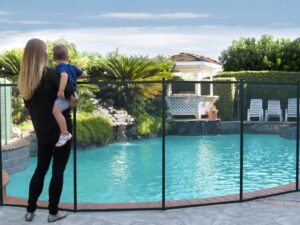
What Makes a Pool Fence Truly “Child-Safe”?
A truly child-safe pool fence does more than meet code. Discover the features parents should prioritize, and how All‑Safe builds fences that families trust.

If small children may use your pool, toddler pool safety is a serious concern. Whether they’re your own children, grandkids, or the children of friends, you want to create a safe fun experience. While toddlers love being in the pool, they’re at a risk their young minds don’t yet comprehend and that their young bodies may not be strong or coordinated enough to prevent. Drowning is the leading cause of accidental death for children up to the age of four. Proactive pool safety is the best way to avoid becoming part of this tragic statistic.
It’s been said that we all should strive to approach life like toddlers: willing to fearlessly attempt new things and quick to push our limits. Parents can tell you just how frightening this can look from the other side of the equation. As their bodies grow, they improve their motor skills and develop a healthy curiosity for the world around them. They also start to express themselves more, which means, in addition to an adorably precocious personality, you could be met with a diminutive person with an outsized stubborn streak.
As part of toddler pool safety, you have to recognize that when they love being in the pool, they don’t understand or want to hear that the pool is closed. Your little mermaid just wants to have fun. Sure, Mom or Dad said no, but they also say you’re getting so big. What’s a mermaid to do? Too often, the choice they would make is not the safe and dry path.
Swimming safety starts before a toe dips into the water, and it keeps going long after the day’s fun is over. The most important part of toddler pool safety is making sure your child is never alone in the pool area.
Once the fun gets started, make sure it doesn’t end on a dangerous note. Toddler pool safety doesn’t mean an end to the splishy, splashy fun. It just means that you’ve taken the steps needed to protect them from themselves.
The Centers for Disease Control cite a lack of barriers as a contributing factor in the majority of water-related deaths. Physical barriers help prevent unsupervised pool entry, and they can be adapted to fit any pool in a way that supports your chosen activities, your pool’s utility, and the personal aesthetics you want for your watery retreat. Professionally installed safety barriers are a great foundation for toddler pool safety.
You can get started right now for free. Your local pool safety professional will take measurements, talk to you about your pool safety needs, and provide you with a written estimate. For many pool owners, peace of mind is more budget-friendly than they believed. Whether you need a cover, fence, or both, your installer will help you understand your options and custom design a plan to fit your pool area. Make toddler pool safety a priority and request your no-cost, no-obligation quote from your local All-Safe Pool installer today.

A truly child-safe pool fence does more than meet code. Discover the features parents should prioritize, and how All‑Safe builds fences that families trust.

Thinking of installing your own pool fence? Discover the benefits of DIY kits, from cost savings and flexibility to safety compliance, and how All‑Safe makes it possible.

Just got a pool? Learn what every new owner should know, from safety codes and barrier options to basic upkeep and seasonal preparation.
Enter your zip code to locate an independent installer in your area
Enter your zip code to locate an independent installer in your area
Their contact info will be shown on the next screen.
Due to the many variations in monitors, phones, and browsers, color samples and product examples may appear different on different screens. Computers and mobile devices are not all calibrated equally and color reproduction on the Internet is not precise. The same is true for printed items such as brochures and other sales literature.
In addition, the colors of our products photograph differently under different lighting conditions. For example, photos taken in full sunlight will vary from photos taken on a cloudy or overcast day. Similarly, shadows from nearby objects can affect the color and transparency of our products. If a precise color or specific shade is important, please inspect the actual color of your product prior to installation.
Many of our products’ materials are not available through typical stores and vendors and therefore must be custom manufactured specifically for our use. In order to control costs and provide you with the best value possible, our raw materials are produced in large batches and can often take several months to receive. The colors of our materials can, and often do, vary slightly from batch to batch. Although we make every effort to minimize color variations, we cannot be responsible for these differences when they occur. If a precise color or specific shade is important, please inspect the actual color of your product prior to installation.
For example, we use the name “putty” to describe some of our products. Your idea of the color “putty” may be different than someone else’s idea of “putty”. In addition, products may have the same color name but may not be the exact same color. For example, we have different shades of “black”. Please do not order using color names as your only guide. If a precise color or specific shade is important, please inspect the actual color of your product prior to installation.
If it is important that your product be an exact color or shade, it is highly recommended that you inspect the actual product prior to its installation and address any concerns with your local independent installer. Most independent installers do not offer refunds or accept returns due to color variations.